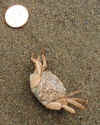

These little crabs are a favorite food of willets, which are diurnal (daytime) feeders. The crabs are scavengers, but are primarily herbivores (plant eaters). Thus most of the crabs’ food grows in the sun. In self-defense the crabs hide under rock in the daytime, and come out to feed at night.
I have watched Curlews (Numenirus Americanus) which have much longer and curved bill, hunt crabs. The birds hold their heads low, and run their bills around the base of the rock.

This is the most common crab in the Estuary. Molted exoskeleton.
We often refer to crab exoskeletons as “shells”. Exoskeletons double as skin and bones. They protect like skin, and serve as sites of muscle attachment like bones.
In order to grow, crabs have to “molt,” change to larger shells. When they are ready, crabs absorb most of the substances (chitin and calcium) from their exoskeleton. Then the part of the shell on the crabs’ back, the carapace, tilts forward like a truck hood. The crab backs out, drinks water, swells about 30% and secretes a new shell.
So what we have here is not a dead crab. It’s an outgrown crab’s shell being recycled, incidentally, like everything in the Estuary. Mr. crab is now the size of a nickel, out in the Bay, somewhere, showing off its new set of clothes!
Molted exoskeletons are feather-light and crumple easily because there is so little left in them.
Sometimes with careful handling, the exit hole can be demonstrated at the back edge of the carapace.
The molted skins tend to catch air bubbles. As a result they float high, are blown easily by the wind, and concentrate on top of the wrack.

